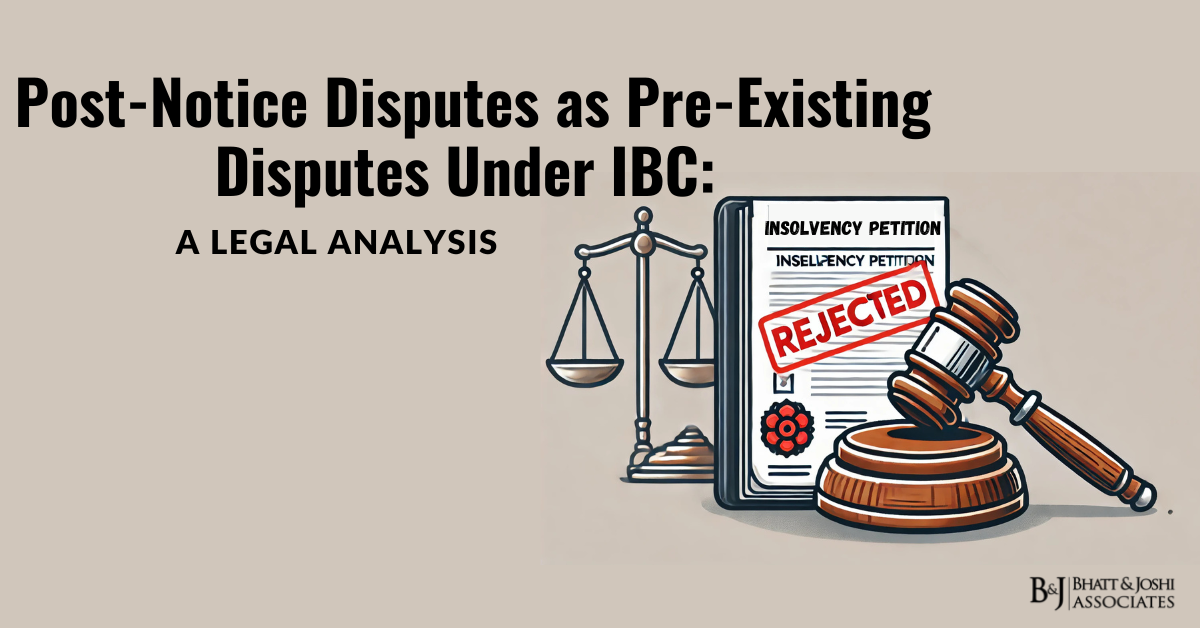Introduction
The Insolvency and Bankruptcy Code, 2016 (IBC), provides a structured mechanism for resolving insolvency disputes, particularly through the Corporate Insolvency Resolution Process (CIRP). A critical aspect of this framework is the concept of a pre-existing disputes under IBC, which, if established, can render an application under Section 9 non-maintainable.
A key question arises: Can disputes raised or legal proceedings initiated after the issuance of a demand notice under Section 8 of the IBC qualify as pre-existing disputes, thereby invalidating a Section 9 application? Through statutory provisions and judicial precedents, this article explores the legal position on post-notice disputes and their impact on CIRP proceedings.
Legal Framework for Pre-Existing Disputes Under IBC
Statutory Provisions: Sections 8 and 9 of the IBC
Section 8(1) of the IBC requires an operational creditor to issue a demand notice to a corporate debtor for unpaid operational debt. The corporate debtor then has 10 days to either:
- Settle the debt, or
- Notify the creditor of a pre-existing dispute under Section 8(2).
If no resolution occurs, the operational creditor may file a Section 9 application to initiate CIRP. However, under Section 9(5)(ii)(d), the adjudicating authority must reject the application if a pre-existing dispute is established.
The IBC defines a “dispute” under Section 5(6) as a legal proceeding related to:
- The existence of the amount of debt,
- The quality of goods or services, or
- The breach of a representation or warranty.
Judicial Interpretation of Pre-Existing Disputes Under IBC
The Supreme Court in Mobilox Innovations Pvt. Ltd. v. Kirusa Software Pvt. Ltd. (2017) established that a dispute qualifies as “pre-existing” only if it existed before the receipt of a Section 8 notice. The Court held:
“The word ‘and’ in Section 8(2)(a) must be read as ‘or’ to prevent corporate debtors from using frivolous disputes to stall legitimate claims. However, the dispute must have arisen prior to the notice to qualify as pre-existing.”
This principle ensures that disputes manufactured after the notice cannot derail CIRP applications.
Judicial Precedents on Post-Notice Disputes
1. G.T. Polymers v. Keshava Medi Devices Pvt. Ltd. (NCLAT)
The corporate debtor filed a commercial suit after receiving a Section 8 notice, claiming it was a pre-existing dispute. The NCLAT rejected this argument, ruling:
“A dispute raised after a demand notice, even if formalized through litigation, cannot retroactively invalidate a Section 9 application.”
2. Vaibhav Aggarwal v. Sunil Sachdeva (NCLAT, 2023)
Here, the corporate debtor failed to respond to the demand notice but later claimed a pre-existing dispute. The tribunal reaffirmed that:
“Failure to reply within 10 days does not preclude proving a pre-existing dispute, but the dispute itself must have existed before the notice.”
3. Brandy Realty Services Ltd. v. Sir John Bakeries India Pvt. Ltd. (NCLAT)
The debtor attempted to introduce post-notice evidence of service quality disputes. The tribunal held that:
“Post-notice evidence can be considered only if it substantiates a pre-notice dispute.”
Evidentiary Standards for Pre-Existing Disputes
Courts have set clear requirements for proving a pre-existing dispute:
- Burden of Proof – The corporate debtor must provide documentary evidence (emails, invoices, legal notices) showing that the dispute existed before the Section 8 notice.
- Timing of Arbitration or Suit Initiation – Only disputes initiated before the demand notice can be considered.
- Frivolous Defenses – Tactical disputes raised post-notice without supporting evidence are not entertained.
For instance, in R.S. Fuel Pvt. Ltd. v. Ankit Metal & Power Ltd., emails challenging service quality before the notice were deemed sufficient to establish a pre-existing dispute.
Critical Analysis of Conflicting Interpretations
Post-Notice Communications as Evidence of Pre-Existing Disputes
Some cases, like Greymatter Entertainment Pvt. Ltd. v. Pro Sportify Pvt. Ltd., allow corporate debtors to submit post-notice evidence if it corroborates a pre-existing dispute. The tribunal stated:
“Verbal disagreements before the notice, later documented in legal responses, may qualify as pre-existing disputes.”
Exceptions for Ongoing Negotiations
In iValue Advisors Pvt. Ltd. v. Srinagar Banihal Expressway Ltd., the NCLAT ruled that ongoing discussions do not amount to a dispute unless they were formally raised before the notice.
WhatsApp Messages and Informal Communications
In Kashyap Infraprojects Pvt. Ltd. v. Hi-Tech Sweet Water Technologies Pvt. Ltd., the NCLT noted that WhatsApp messages can be considered evidence, but their weight depends on corroboration through official documents.
Distinguishing Genuine vs. Tactical Disputes
Courts have drawn a distinction between:
- Genuine pre-existing disputes – Supported by prior evidence such as emails, termination notices, or legal correspondences.
- Tactical post-notice disputes – Raised solely to delay insolvency proceedings and unsupported by pre-notice evidence.
For instance, in Shashank Keshav Kalkar v. Raychem RPG Pvt. Ltd., a post-notice arbitration notice was dismissed as irrelevant.
Conclusion: The Imperative of Temporal Specificity
The IBC aims to streamline debt resolution by preventing frivolous delays. Courts have consistently ruled that:
- A dispute must have originated before the Section 8 notice.
- Mere post-notice litigation or arbitration does not qualify as a pre-existing dispute.
- Documentary evidence supporting pre-notice disputes is essential.
This reinforces the IBC’s objective of balancing creditor rights with safeguards against misuse by debtors.














